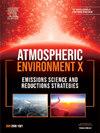Distribution of polycyclic aromatic compounds among various phases in an urban road microenvironment of a tropical megacity
IF 3.4
Q2 ENVIRONMENTAL SCIENCES
引用次数: 0
Abstract
Quantitative research on characteristics of PAHs prevalent in urban road microenvironments (URM) is vital to emphasize the seriousness of health risks and reduce exposure among commuters and nearby residents, especially in Indian cities where the traffic emissions (exhaust and non-exhaust) are the major contributors to atmospheric particulates in an urban area. The present research investigates the distribution and correlation of Polycyclic Aromatic Hydrocarbons (PAHs) found in various phases (PM10, PM2.5, resupendable road dust (RRD) and gaseous phase) at urban road microenvironment (URM) using Two-way ANOVA analysis. The sources and health risk associated with PAH exposure is also estimated. PM10 and PM2.5 samples were collected on the kerbside using high-volume samplers, and RRD was collected at eight contrasting locations using EPA AP-42 methodology. A total of 64 PAHs were analyzed using GC-MS and incremented life cancer risk (ILCR) was estimated for children and adults by calculating toxicity equivalents using three different approaches. Average PAHs concentration varied from 75 to 175 μg/g for PM10, 30–80 μg/g for PM2.5, and 01–03 μg/g for RRD. Gaseous phase ∑PAH was found to be in the range of 0.5–2.75 μg/m3. It was found that high molecular weight PAHs such as Coronene, Pyrene, Indeno(1,2,3-c,d)pyrene and Benzo ghi perylene were the major contributing compounds in the urban road microenvironment. A strong correlation between PAHs bound to PM10 and RRD was found at all the sampling locations. Further, ILCRs of total cancer risk due to inhalation of PM were in the range of 1.61E-05 to 2.05E-03. However, the risk due to exposure to RRD was within an acceptable risk of 1E-06. The current study highlights the scientific backing for RRD-specific regulations, which are currently absent, to control non-exhaust emissions in India.
热带特大城市道路微环境中多环芳香族化合物的分布
对城市道路微环境(URM)中普遍存在的多环芳烃特征进行定量研究,对于强调健康风险的严重性并减少通勤者和附近居民的接触至关重要,特别是在交通排放(尾气和非尾气)是城市地区大气颗粒物主要贡献者的印度城市。采用双因素方差分析(Two-way ANOVA)研究了城市道路微环境(URM)中不同相(PM10、PM2.5、可再生道路粉尘(RRD)和气相)中多环芳烃(PAHs)的分布及其相关性。还估计了多环芳烃接触的来源和健康风险。使用大容量采样器在路边收集PM10和PM2.5样本,并使用EPA AP-42方法在8个不同地点收集RRD。使用气相色谱-质谱分析了64种多环芳烃,并通过使用三种不同的方法计算毒性当量来估计儿童和成人的增加生命癌风险(ILCR)。PM10的平均PAHs浓度为75 ~ 175 μg/g, PM2.5为30 ~ 80 μg/g, RRD为01 ~ 03 μg/g。气相∑PAH在0.5 ~ 2.75 μg/m3之间。结果表明,冠烯、芘、茚二(1,2,3-c,d)芘和苯并基苝等高分子量多环芳烃是城市道路微环境的主要贡献物质。在所有采样地点均发现与PM10结合的多环芳烃与RRD之间存在很强的相关性。此外,吸入PM的总癌症风险的ilcr在1.61E-05至2.05E-03之间。然而,暴露于RRD的风险在可接受的1E-06风险范围内。目前的研究强调了目前缺乏的针对rrd的法规的科学依据,以控制印度的非废气排放。
本文章由计算机程序翻译,如有差异,请以英文原文为准。
求助全文
约1分钟内获得全文
求助全文
来源期刊

Atmospheric Environment: X
Environmental Science-Environmental Science (all)
CiteScore
8.00
自引率
0.00%
发文量
47
审稿时长
12 weeks
 求助内容:
求助内容: 应助结果提醒方式:
应助结果提醒方式:


